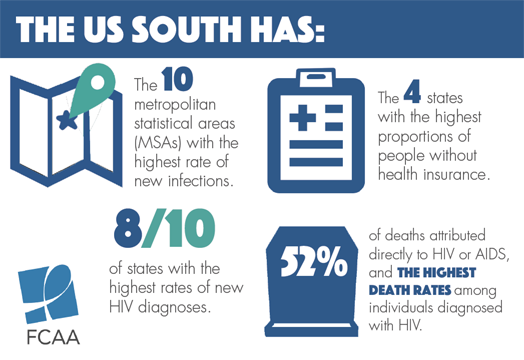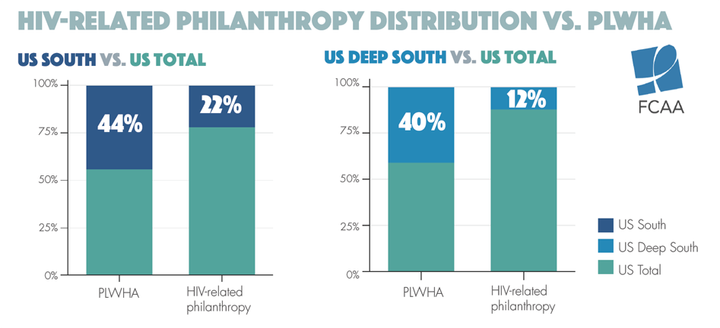Recently, Mississippi’s State Department of Health announced it will no longer offer HIV screenings for free. Effective July 1, the Health Department began charging a $25 fee for all sexually transmitted diseases and HIV tests and lab work at all of its clinics. You may think that this is a relatively nominal fee and unlikely to have many ill effects. Think again.
What is happening in Mississippi is, in fact, fueling an already raging fire. The U.S. South is home to 44 percent of all people living with HIV/AIDS in the country.

The situation is even more dire in “Deep South” states, [1] which include Mississippi. Not only do these nine states have the highest HIV and AIDS diagnosis rates and numbers, 43 percent of all HIV-related deaths in the country take place here. At the same time, in other U.S. cities such as New York and San Francisco, HIV rates are dropping precipitously, creating the mistaken perception that national resources can be scaled back. In reality, we are creating a chasm in the response.
The reasons behind the AIDS crisis in the U.S. South are complicated. Higher poverty rates certainly play a part. Four states in the region have the largest proportion of uninsured people in the country. Tacking a fee onto testing services, as Mississippi is doing, will, of course, only exacerbate existing financial barriers to receiving care.
Varying levels of political will — with, for example, some states refusing to expand Medicaid — is also a driver of disparate outcomes. But stigma and discrimination are significant factors as well. Carolyn McAlister, of the Southern HIV/AIDS Strategy Initiative, explained it this way:
“These states are all within the Bible belt and have a legacy of slavery and racism that continues to reverberate. The largest population of those affected by HIV and AIDS are young, gay and bisexual men, particularly men of color. These factors converge to contribute greatly to stigma.
The church, for example, is an extremely important institution in the Deep South. Consider for a minute that the church rejects you because you happen to be HIV positive and gay. Not only are you grappling with the effects of the disease, but the support you have received and the community you have relied upon in the church for your entire life have been taken away as well.”[2]
In southern cities, many young, gay men of color are not learning their HIV status until they are diagnosed with opportunistic infections, the likes of which have not been seen in the U.S. since the early days of the epidemic. Such late diagnosis results in worse health outcomes and drives new infections. Without addressing these challenges, we will not be able to control the epidemic. And, we certainly won’t be able to end it as a threat to public health any time soon, if ever.
So what must we do? Certainly, building political will is absolutely essential. Leadership decisions to add barriers, such as fees for testing, are utterly counterintuitive to solving the crisis.
Closing the funding gap is also imperative. The U.S. South receives less than 20 percent of total, nationwide HIV-related philanthropy. Philanthropic funders have made significant investments to support organizations working to provide HIV services and advocacy in the South. However, in 2014 and 2015, only $31 million in HIV-related philanthropy was directed to the region on an annual basis. This is roughly $59 per person living with HIV (PLWHIV) in the region, as compared to $116 per PLWHIV allocated nationally.

Beyond financial resources, funders must work collaboratively, identifying ways to coordinate efforts, strengthen existing community leadership, and build a pipeline of new leaders who reflect the populations most impacted in the U.S. South.
Improving communications capacity and helping community-based organization to build and participate in coalitions is also critical to affecting change. Funders like the Elton John AIDS Foundation — the fourth largest private funder of HIV-related work in the U.S. South — are investing heavily in community-based activists and organizations that are leading the response at the local level for black, gay, and transgender communities across the southern U.S.
AIDS United’s Southern REACH initiative is another excellent example. With the support of the Ford Foundation, this effort has provided $12 million in funding over the past 10 years to build advocacy capacity. Today, it represents the single-largest funding source for HIV policy and advocacy in the South.
Efforts like those referenced above will help to drive progress. What we should not do is add to the enormity of the crisis. Yet, that is precisely what Mississippi has done with this recent decision. It has fanned a fire that already threatens to burn out of control. In response, funders, advocates and others in the fight must join together to apply pressure to our state and national leaders, mobilize resources and coordinate efforts. That is the only way we will be able to put out this blaze.
[1] As defined by the Southern AIDS Strategy Initiative, Alabama, Florida, Georgia, Louisiana, Mississippi North Carolina, South Carolina, Tennessee and Texas
[2] SASI’s report, HIV/AIDS in the U.S. Deep South: Trends from 2008-2013, is an excellent resource on the HIV and AIDS crisis in the U.S. South.
